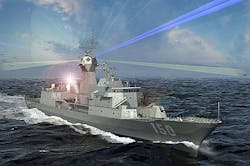Raytheon joins DRS in Navy research to develop high-power electronics for ships and submarines
TEWKSBURY, Mass., 12 Oct. 2012. Raytheon Co. Integrated Defense Systems segment in Tewksbury, Mass., will develop key enabling power electronics technologies for a shipboard electronics program to provide better fuel economy, architectural flexibility, and electrical power for high-power electronics on Navy surface ships and submarines.
Officials of the Office of Naval Research in Arlington, Va., awarded Raytheon two phase-2 contracts as part of the Compact Power Conversion Technologies (CPCT) program, which focuses on developing power-dense power conversion components and system level controls that enable high power systems for pulsed loads on advanced radars, sensors, and high-energy weapons.
The CPCT program, which is part of the Navy’s Next Generation Integrated Power Systems (NGIPS) initiative, which to mature high-power electronics technology and power distribution that directs large amounts of electric power where it is most needed aboard surface ships and submarines.
Raytheon joins the DRS Technologies Inc. Power & Control Technologies in Milwaukee on the CPCT program. DRS won an ONR contract last month design and demonstrate an advanced shipboard high-power electronics-control system that provides sufficient power for the future Navy Air and Missile Defense Radar (AMDR) for Navy Arleigh Burke-class destroyers.
ONR' $3.7 million contract to DRS is for the third phase of the CPCT program, which seeks to satisfy needs of the Navy Electric Ships Office (PMS320) to power the future AMDR.
Raytheon experts, in their phase-2 CPCT contract will develop bi-directional power converter and power management controller technology that enable new energy-efficient ship power systems for high-power radar, energy storage, pulsed loads, and motor drives.
This technology should reduce shipboard weight and volume by a factor of three, while achieving efficiency of 96 to 98 percent, Raytheon officials say. In addition, this technology should be able to provide power for several classes of ships with built-in spares and redundancy.
Raytheon also will develop a power management controller that enables a new generation of intelligent shipboard power control. The system can balance planned and unplanned pulse power loads with the computer-controlled use of all components in the power system.
This capability can provide higher performance with an existing power system or minimize the equipment required when designing a new system, Raytheon officials say.
With such capabilities in place, ships no longer might require discrete energy storage for separate systems. Instead, these new power-control technology would collective store, share, and distribute power as required.
For more information contact Raytheon Integrated Defense Systems online at www.raytheon.com/businesses/rids, or ONR at www.onr.navy.mil.
Follow Military & Aerospace Electronics and Avionics Intelligence news updates on Twitter

